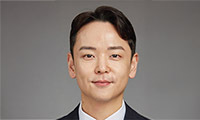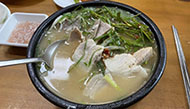Immigrants: How it Was for One Family
▶ Los Angeles Survival
▶ By Ellen Thun
It was the firstborn American, John, who talked about Kauai. He was retired, going on 70 years, sitting in his Los Angeles home with his wife, Minnie You, beside him. She was the mother of his four children: Kenneth, Charlotte, Lorna (after Lorna Doone, John’s favorite heroine) and Elaine. They were grown now, with families of their own. Kauai, he said, happened long ago and he had come a distance from the place of his birth. He would tell what he recalled, but it was not much. He wasn’t one to embellish, he left that to women. Giving Minnie and me the eye. He began, “I remember how it was for the men of the family, especially grandfather. They were always served first. Each had his own set of dishes, spoons and chopsticks, and were served on little tables. Later when there were dining table and chairs they still were served first, and women and children after.” John was a small boy then. Was he thinking, “One day when I am a man, I’ll be served first.” But Korean traditions were to give way to American ways, which were usually more convenient for the women! But Haraboji continued to be honored as head of the family, and John admired him immensely. He described him as “tall, nice looking, with silvery hair, and he always wore Korean clothes on the plantations.” It wasn’t until the family moved to Oahu that the old man adopted American trousers, wore a homburg hat and carried a cane. John’s father was small, in contrast, standing by Haraboji, about 5 feet, 6 inches. He was a quiet man, was educated in the Old Country and did not learn English. His mother did not learn either. They were upset, as were the other parents, when the kids spoke to them in English. It was terrible, they scolded, not to understand your own children. The parents solved that problem at once, they started Korean language classes: One hour before public school attendance, one hour after school, making for a long day. The subjects were everything Korean: Korean geography, Korean history, Korean language (ka, na, da. . .), Korean arithmetic (hana, dool, set. . .), except the Chinese 1000 characters. Saturday was no different, they studied. Who were their teachers? John had no recollection. Yet he recited the names of his public school teachers and principals and was enthusiastic about Mr. Smith, 4th grade principal who put in a telephone system to the classrooms to keep in touch with instructors and pupils. “That was progressive,” he said. “You liked school,” I said, “you should have gone on to college.” He said, no, college was for his brothers; that he was not smart like them, referring to his brothers Jacob and Jack. Well, John did not need a diploma for business excellence. He’d started with a vegetable stand in Los Angeles, worked at it for years, bought into a market stall downtown, and it was wartime when the city mushroomed. He said he could not help but make money. The produce business was big business. When he retired his son took over and made it into a multimillion dollar enterprise, and he had no degree after his name.
About plantation life: he said his parents moved from plantation to plantation. With each move he changed schools. Going to school meant walking and he walked rain or shine. The schools were not often near the plantations and it really meant walking. The longest distance was to Lihue, the island capital, which he said was eight miles. Dan went with him, so he did not mind the distance. About plantations themselves? He said the owners were “slave drivers”. He was 10 years old but he recognized the dark side of people. His father decided to move to Oahu, where the Dole company offered subcontracting pineapple fields. Haraboji reached his 75th birthday and no longer a wage earner, younger workers replaced him. It was time to leave, the two men agreed, and the family left Kauai.
Nak Joon and Simoon were not the stuff immigrants are made of. They were not aggressive, quick to adapt, quick-witted. They were ordinary people and they did not find the fields greener on Oahu. It was their 14-year-old son, Dan, almost 15, who met up with his future in Honolulu. It was the automobile. He had an instinct about cars and the owner of the taxi cab knew it at once, seeing this big country youth who eyed the silver Packard, strolled around it, looked as if he might get into it but did not touch, and moved away. The owner spoke. Dan listened. Yes, he liked the car. Someday he’d have a Packard convertible like this one. The owner said to get in and take a ride, “No charge.” Dan took his first ride in his dream car. He learned to drive it, and was offered a job. He’d be paid. His parents were surprised anyone would pay their son to drive a car. More so, when he became actively a wage earner. They had not been successful with the pineapple fields, and came into Honolulu to run a dry cleaning business, which had no customers. Nak Joon had many jobs, one as stevedore. Dan was in an accident, the car damaged, but he walked away with no physical harm to himself other than bruises and a shake up. However, he was weak for almost a year, unable to drive. Because he moved about, no one thought he should see a doctor. Doctors were for sick people. When he was well enough, the taxi owner offered him his old job, adding a bonus: Dan was made part-owner. He was in the taxi cab business for the rest of his life, although he was into many ventures. He had this feeling: to hang on to his dream car.
When John left school he told his parents he was getting married. He would get a job and he and Minnie would have a place of their own and be a family. He thought his words were manly, revealing what was uppermost in his mind: his love for his sweetheart through high school. Simoon, his mother, reacted, and in Korean too. “Aigo! Aigo!” was her cry of alarm. If only she had beat her breast and stopped there, her point would have been made. But she went on in a long Korean monologue. John must wait. Dan was the older. He must marry first, it was his right. It was Korean custom. John argued. “What about Frank and Jacob in California, they’re older than Dan.” And wished he had not mentioned their names. Since he could remember, mentioning their names would bring out her lament how they had been taken from her and that Nak Chung the uncle failed to teach them respect for their true parents in Hawaii. Adding, “They never send money home.” Although Simoon well knew the California relatives were no better off than they were in the Islands. There was that time that I cannot forget, when cousins Rose and Mary, hearing of the plight of the children in the orphanage, were quick to write, sending photographs, packages of Hawaiian trinkets, shell beads, postcards, paper leis, even a small ukulele that was mistaken for a toy, yet made a plinky-plinky sound sweet to hear. To thank them, we were allowed to reply twice, penciled notes written on scratch paper, the cost two 2 cents postage stamps. Then in 1924, the year sister and I were placed in American homes as “mother’s helper”, a photograph of Dan and his Picture Bride came. In the shuffle of moving the Honolulu address was lost and no reply was sent. The wedding picture was kept.
John and Minnie married. John found a well-paying job, painting auto bodies with a spray gun, a newfangled invention that did away with paint brushes. He learned a skill that one day would help him in Los Angeles. But at the moment his mother was still disgruntled he had married ahead of Dan, and was not concerned about his future employment. She went about finding a wife for Dan, before anymore traditions were broken. she started her search and it was for a picture bride. A Korean born wife, who would be an immigrant like herself, Nak Joon and Dan.
Between 1912 and 1924, there were 950 Korean picture brides who entered the country, usually through Honolulu. Marriage brokers or go-betweens handled the transaction. It was a business with them. Their fees were 500 dollars for the bride money and another like sum for the brokers or go-between. The Korea Maru was the last ship to bring picture brides from the Orient. Dan’s picture bride was on the ship. She was Phyllis Bok Dung Chu, born September 1906, in Kyongsang-namdo. Her home was Tongnai, near Pusan. Tongnai looked a Japanese-ruled settlement. Neglected. The houses were small, with thatched roofs turned brown, matching the clay walls, the streets only footpaths and treeless, with no flowers to give color to the drabness. Yet Phyllis was to speak of leaving Tongnai with sadness. She said the town was her childhood haven. Her father died when she was six, leaving mother and child without support. Her mother asked for help from her husband’s brother, a landowner in the district. He was wealthy and purse-proud. When mother and child arrived, they were not greeted and shown a hut some distant away on the land. It was winter. The hut was bare and cold. The ancient stove had not been fired for sometime and took time to heat. Her mother was capable of meeting any emergency. There was no door on the hinges; she took one of her huge comforters and draped it to keep out the cold. The stove that took up one wall space heated the single room, at the same time boiled water for the rice and to fill a wash basin to clean themselves of travel stains. Phyllis recounted that day as if it happened last week. Her mother was expected to help in the uncle’s house. Otherwise, she and her child were no part of the family. Her mother did not take life’s blows passively. She learned where the church was nearby and attended, meeting other Koreans. Her mother was a lively person and was welcomed and soon courted by an older man who was a widower. He had a home in Tongnai and worked in Pusan. Before the year had gone by, her mother married and Phyllis had a home with a caring and kind father. When she was 17, the father died. Her mother contributed to the family income after she married so she was not entirely destitute by his death. However, selling silk goods to Koreans living on the offshore islands was not enough to keep mother and daughter. The church they attended was Episcopal and the members obeyed the Bible teaching to do good works. One of the good works was finding brides for the men in the Hawaiian Islands. Phyllis decided she would be one of the picture brides and talked it over with her mother. Or rather, she told her mother what she planned to do. Her mother did not try to dissuade her. Instead, studied the photograph of the young man that had been sent and said, “If the picture is a true one” — often pictures were substituted by both women and men — “he will make a good husband.” Phyllis’s thought was “How handsome Dan looks.”
스마터리빙
more [ 건강]
[ 건강]이제 혈관 건강도 챙기자!
[현대해운]우리 눈에 보이지 않기 때문에 혈관 건강을 챙기는 것은 결코 쉽지 않은데요. 여러분은 혈관 건강을 유지하기 위해 어떤 노력을 하시나요?
 [ 건강]
[ 건강]내 몸이 건강해지는 과일궁합
 [ 라이프]
[ 라이프]벌레야 물럿거라! 천연 해충제 만들기
 [ 건강]
[ 건강]혈압 낮추는데 좋은 식품
[현대해운]혈관 건강은 주로 노화가 진행되면서 지켜야 할 문제라고 인식되어 왔습니다. 최근 생활 패턴과 식생활의 변화로 혈관의 노화 진행이 빨라지고
사람·사람들
more
[한인단체 신년 인터뷰] 명원식 파바월드 회장… “한인 차세대 바르게 성장하는 토대 최선”
“한인 차세대들이 바르게 자랄 수 있는 토대를 만드는 것이 제가 파바월드의 회장으로 존재하는 유일한 이유입니다”한인사회의 대표적 청소년 봉사 …

LA한인회 멘토 프로그램 10일 스티브 강 위원장
LA 한인회(회장 로버트 안)가 한인사회 차세대 인재양성 노력의 하나로 ‘멘토를 만나다’ 프로그램을 정례화해 실시하고 있는 가운데 그 세 번째…
미주 한인의 날 기념… 잇달아 ‘코리안 나잇’
미주 한인들의 역사와 성취, 그리고 미국 사회에 기여해 온 발자취를 기리는 1월13일 ‘미주 한인의 날’을 맞아 LA의 주요 프로 스포츠 구단…
‘K-팝의 미래’ 세미나 16일 LA 문화원 개최
LA 한국문화원(원장 이해돈)은 세계한류학회(WAHS)와 함께 오는 1월16일(금) ‘케이팝 데몬 헌터스와 케이팝의 미래 세미나 및 라운드테이…
[한인단체 신년 인터뷰] LA 한인회 로버트 안 …
“더욱 적극적이고 실질적인 서비스로 한인들의 어려움을 돕고, 한인사회 발전에 앞장서겠습니다.”2026년 병오년 새해를 맞아 LA 한인회 로버트…
많이 본 기사
- 미니애폴리스서 30대 여성, 이민단속요원 총격에 사망
- 트럼프, 천정부지 집값에 “기관투자자 단독주택 매입금지 추진”
- 베네수 대통령 경호실장 해임…마두로 체포 ‘배신자’?
- ‘캄보디아 스캠범죄 설계자’ 프린스그룹 천즈, 체포돼 中송환
- 트럼프, 방산기업들에 “배당할 돈으로 생산·유지보수 주력하라”
- 머스크, 엔비디아 자율주행기술 견제… “5∼6년 이상 걸릴것”
- 美, 베네수 석유자원 관할 본격화…경제이익·中견제 동시 추구
- ‘AI 강자’ 구글, 시총 2위로 올라서…6년여만에 애플 제쳐
- 다우, 첫 49,000 돌파 증시 연초 랠리 지속
- ‘주사 이모’ 집 털렸다..박나래, 19금 행위 폭로→경찰 소환까지 ‘첩첩산중’
- “JP모건체이스, 골드만삭스 대신 애플카드 발행 맡기로”
- ‘오징어 게임3’, 美배우조합 ‘스턴트 액션연기상’ 후보 올라
- 뉴욕증시, 애플마저 아래에 둔 알파벳…혼조 마감
- 해외 IB “올해도 美 성장률 韓보다 높아”…환율 상승 요인
- 국무 “내주 덴마크와 그린란드논의…군사옵션 모든 현안에 유효”
- 일자리 위협하는 AI, 전문직도 대체한다… 컴퓨터 전공·로스쿨 졸업생들도 ‘취업난’ 극심
- “조폭 해외 도피→조세호 복귀”..폭로자, 분노 못 참고 또 글 올렸다
- G7외교장관, ‘포스트 마두로’ 베네수엘라 정권이양 논의
- “원하는 건 뭐든지 도널드”…마크롱 또 조롱한 트럼프
- 美, ‘베네수와 연계’ 러 유조선 나포…미러 신경전 조짐
- 트럼프 “나토가 우리 돕지 않더라도 우린 항상 나토 도울 것”
- 멕시코, 對쿠바 원유수출 1위… “베네수엘라 상황 여파”
- 뉴욕시 ‘숨은 수수료’ 퇴출 나섰다 1
- 워너브러더스, 파라마운트 인수 제안 또 거부… “자금 조달 우려”
- 케네디에 관한 네 개의 이야기
- 국무 “제재로 수출 막힌 베네수 원유 미국이 인수해 판매”
- “다저스가 기대한 그대로” 반쪽짜리였던 김혜성, 美 매체가 호평한 이유
- 다니엘 ‘뉴진스 퇴출’..팬덤은 ‘대중에 퇴출’ 엔딩
- 내란특검, 尹구형 앞두고 공소장 변경…계엄모의 2023년 10월로
- ‘마구잡이 이민단속’ 제한 법안 속속 진전
- 하원세출위, 韓 온라인 플랫폼 법안에 “中기업만 유리” 우려
- 국뽕과 2세들에게 씌운 족쇄
- “예년보다 빠르고 거세다”
- 우크라 안전보장 충분할까… “역대 가장 강력” “종이호랑이”
- ‘콜록콜록’ …워싱턴 독감환자 폭증
- ‘비자 보증금’ 대상 확대… 최대 1만5천달러 내야
- 조국사랑미주연합 · 한미충효회, 제9회 신년하례 초청모임
- 미국서 비만 치료제 시장 전쟁 ‘본격’
- 인공지능 두뇌 장착 로봇… 완전체 자율주행차도
- 李대통령, 서울 도착…방중 성과 살리고 국내 현안 점검 나서
- “사면 감사합니다. MAGA는 영원하다”
- [마크 A. 시쎈 칼럼] 트럼프의 20가지 업적
- JP모건, 주총 의결권 행사에 AI 활용…의결권 자문사 배제
- 콜비 美국방차관, 이달 말 한일 연쇄 방문 추진
- VA 재무차관에 한인 제임스 허
- 에너지장관 “미국이 베네수 원유 판매 무기한 통제할것”
- 손담비, 시동생 성폭행 ‘악플 소송’ 냈다.. “50만원 배상하라”
- “숫자 다루는 직업이지만 사람간 소통 · 신뢰가 먼저죠”
- [미국은 지금] 2026년 ‘손님’ 의식 버리고 ‘주인’ 입장을
- 메디케어 보험 가입 마감 31일까지 연장
1/5지식톡

-
 미 육군 사관학교 West Poin…
0
미 육군 사관학교 West Poin…
0https://youtu.be/SxD8cEhNV6Q연락처:wpkapca@gmail.comJohn Choi: 714-716-6414West Point 합격증을 받으셨나요?미 육군사관학교 West Point 학부모 모…
-
 ☝️해외에서도 가능한 한국어 선생님…
0
☝️해외에서도 가능한 한국어 선생님…
0이 영상 하나면 충분합니다!♥️상담신청문의♥️☝️ 문의 폭주로 '선착순 상담'만 진행합니다.☎️ : 02-6213-9094✨카카오톡ID : @GOODEDU77 (@골뱅이 꼭 붙여주셔야합니다…
-
 테슬라 자동차 시트커버 장착
0
테슬라 자동차 시트커버 장착
0테슬라 시트커버, 사놓고 아직 못 씌우셨죠?장착이 생각보다 쉽지 않습니다.20년 경력 전문가에게 맡기세요 — 깔끔하고 딱 맞게 장착해드립니다!장착비용:앞좌석: $40뒷좌석: $60앞·뒷좌석 …
-
 식당용 부탄가스
0
식당용 부탄가스
0식당용 부탄가스 홀세일 합니다 로스앤젤레스 다운타운 픽업 가능 안녕 하세요?강아지 & 고양이 모든 애완동물 / 반려동물 식품 & 모든 애완동물/반려동물 관련 제품들 전문적으로 홀세일/취급하는 회사 입니다 100% …
-
 ACSL 국제 컴퓨터 과학 대회, …
0
ACSL 국제 컴퓨터 과학 대회, …
0웹사이트 : www.eduspot.co.kr 카카오톡 상담하기 : https://pf.kakao.com/_BEQWxb블로그 : https://blog.naver.com/eduspotmain안녕하세요, 에듀스팟입니다…
케이타운 1번가
오피니언
 정숙희 논설위원
정숙희 논설위원케네디에 관한 네 개의 이야기
 마크 A. 시쎈 / 워싱턴포스트 칼럼니스트
마크 A. 시쎈 / 워싱턴포스트 칼럼니스트 [마크 A. 시쎈 칼럼] 트럼프의 20가지 업적
 김동찬 시민참여센터 대표
김동찬 시민참여센터 대표 [미국은 지금] 2026년 ‘손님’ 의식 버리고 ‘주인’ 입장을
 이현숙 수필문학가협회 이사장
이현숙 수필문학가협회 이사장 [수요 에세이] 이젠 끝이다 “Nevermore, Nevermore”
 최형욱 / 서울경제 논설위원
최형욱 / 서울경제 논설위원 [만화경] ‘가짜 일’ 줄이기
 민경훈 논설위원
민경훈 논설위원도널드 W 부시와 이라크 전의 추억
 황의경 사회부 기자
황의경 사회부 기자 타국에서, 다시 ‘우리’를 생각하다
 박원곤 이화여대 북한학과 교수
박원곤 이화여대 북한학과 교수 [백상논단] 붉은 말의 해, 한반도에 다시 오는 분기점
 홍용희 수필가
홍용희 수필가 [화요칼럼] 내 안의 바위
1/3지사별 뉴스

뉴욕시 ‘숨은 수수료’ 퇴출 나섰다
뉴욕시가 일반 소비 시장에 만연해 있는 ‘숨은 수수료’(Junk fee) 근절에 나섰다. 조란 맘다니 뉴욕시장은 5일 ‘숨은 수수료’ 및 ‘…
‘마구잡이 이민단속’ 제한 법안 속속 진전

VA 재무차관에 한인 제임스 허
30대 중반의 한인 제임스 허 씨(사진)가 버지니아 재무차관(Deputy Secretary of Finance)에 내정됐다. 아비가일 스팬버거…
‘콜록콜록’ …워싱턴 독감환자 폭증

‘안면 인식’으로 불체자 확인·체포한다
트럼프 행정부의 초강경 이민 단속 기조 속에 불법체류자 단속을 위해 안면 인식 기술이 본격적으로 활용되고 있어 논란이 커지고 있다. 4일 월스…
중부 캘리포니아 ‘한인 이민사’ 나왔다

오늘 하루 이 창 열지 않음 닫기 


















































.png)


댓글 안에 당신의 성숙함도 담아 주세요.
'오늘의 한마디'는 기사에 대하여 자신의 생각을 말하고 남의 생각을 들으며 서로 다양한 의견을 나누는 공간입니다. 그러나 간혹 불건전한 내용을 올리시는 분들이 계셔서 건전한 인터넷문화 정착을 위해 아래와 같은 운영원칙을 적용합니다.
자체 모니터링을 통해 아래에 해당하는 내용이 포함된 댓글이 발견되면 예고없이 삭제 조치를 하겠습니다.
불건전한 댓글을 올리거나, 이름에 비속어 및 상대방의 불쾌감을 주는 단어를 사용, 유명인 또는 특정 일반인을 사칭하는 경우 이용에 대한 차단 제재를 받을 수 있습니다. 차단될 경우, 일주일간 댓글을 달수 없게 됩니다.
명예훼손, 개인정보 유출, 욕설 등 법률에 위반되는 댓글은 관계 법령에 의거 민형사상 처벌을 받을 수 있으니 이용에 주의를 부탁드립니다.
Close
x